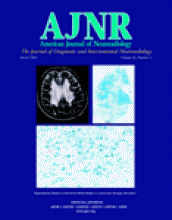Abstract
BACKGROUND AND PURPOSE: Partial volume with CSF is known to contaminate the quantification of white matter anisotropy depicted by diffusion tensor imaging (DTI). We hypothesized that the FLAIR technique helps to improve DTI white matter tractography in the normal adult brain by eliminating CSF partial volume effects.
METHODS: Seven healthy adults aged 23–37 underwent both conventional and FLAIR DTI at 1.5T. Each subject was imaged five times. Neural fiber tractography was performed with both sequences by using two algorithms: a voxel-based method (EZ-tracing) with global seed points and another based on subvoxel tractography (tensor deflection) by using manual encircling of local seed points. Total volume of the fibers tracked was compared for the two types of images.
RESULTS: Fiber tracking was substantially most successful on FLAIR DTI near the lateral ventricles and the sulci, where CSF partial volume effects were likely present. Minor false tracts on FLAIR images, possibly due to a reduced signal-to-noise ratio, were found in regions relatively free of CSF contamination; however, they did not affect tracking of major periventricular white matter bundles, such as those related to the corpus callosum or the corona radiata. When we excluded false tracts, the FLAIR technique depicted an average of 17% more fibers in volume than conventional DTI in the periventricular regions (P < .0005, paired Student t test).
CONCLUSION: Despite the reduction of signal-to-noise ratio and longer imaging times, FLAIR improved tractography by eliminating CSF partial volume effects.
- Copyright © American Society of Neuroradiology












